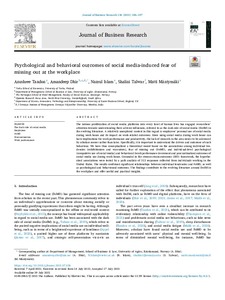Psychological and behavioral outcomes of social media-induced fear of missing out at the workplace
Tandon Anushree; Dhir Amandeep; Islam Nazrul; Talwar Shalini; Mäntymäki Matti
https://urn.fi/URN:NBN:fi-fe2021093048906
Tiivistelmä
The intense proliferation of social media platforms into every facet of human lives has engaged researchers' attention towards understanding their adverse influences, referred to as the dark side of social media (DoSM) in the evolving literature. A relatively unexplored context in this regard is employees' personal use of social media during work hours and its impact on work-related outcomes. Since using social media during work hours can have implications for work performance and productivity, the lack of research in the area needs to be addressed by scholars sooner rather than later. Specifically, it is important to understand the drivers and outcomes of such behaviour. We have thus conceptualized a theoretical model based on the associations among individual tendencies (exhibitionism and voyeurism), fear of missing out (FoMO), and individual-level psychological (compulsive use of social media) and behavioral (work performance decrement and procrastination) outcomes of social media use during work hours. Grounded in the stressor-strain-outcomes (SSO) framework, the hypothesized associations were tested by a path analysis of 312 responses collected from individuals working in the United States. The results confirmed significant relationships between individual tendencies and FoMO, as well as psychological and behavioural outcomes. The findings contribute to the evolving literature around DoSM in the workplace and offer useful and practical insights.
Kokoelmat
- Rinnakkaistallenteet [27093]
